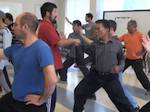1. Beginning. 2. Yin Yang separation. 3. Differential 1. 4. Differential 2. 5. Differential 3. 6. Differential 4. Presenter: Chen Zhonghua Length: 43 min. In: English Year: 2012 Difficulty:4/5 At:Edmonton
“Differential 2” Online Video Trailer
Previous post: Daqingshan update
Next post: Aaron Robert Bartholomew Application



{ 5 comments… read them below or add one }
Wow! All so incredibly well explained and clear. Thank you so much!
Another great video. First time I have an explanation of how the trigrams fit into taichi.
“yilu is for learning, for getting the theory and erlu is for applications” – this alone makes watching worthwhile. Highly recommend this clip, even if you might not be “there” yet. It’s a lot of theory and gives you something to think about just “how” applications might work. Far better than being confined to only learning some special move that fits a particular situation.
This video could be called use of yin and yang in Taijiquan. It is a fairly long video, which is good. It could be 3 or 4 shorter lessons, on related topics, but as a long video it conveys a sense of continuity so that you realize there is only one topic there.
Shifu Chen starts by discussing yin and yang separation. He then begins discussing using yin and yang to create a differential and he goes into several ways to do that. There is a lot of theory, but also many clear demonstrations that can help a viewer understand what is going on. This video helps make a lot of disparate teachings come together.
It is a treasure trove of knowledge.
The egg-shape is used in engines as a camshaft.
It is a 2D model of what is used in practical method as a 3D model.
On the Wikipedia-camshaft computer animation we can see very clearly the opening and closing energy of the piston. When the tip of the piston is on the tip of the “egg” going down, the energy opens, in the reversal the energy closes.
The egg shape contains a part of a circle at the bottom.
On a circle motion the value of centripetal acceleration(centripetal force-Wikipedia) a, is:
a = rωω
where, r is radius
ω is angular velocity of rotation.
But in our 2D egg from camshaft r increases in the opening energy resulting the acceleration in the tip of piston growing .More than that, we can increase the rotation and because it is square, acceleration will be exponential increase, not linear.
Considering centripetal force F in the tip of piston:
F = ma
where, m is mass
a is centripetal acceleration,
When acceleration increases, F increases in the first part reaching F1 value. Then through rotation on the circle part of the “egg” F1 is kept constant. After this the F1 value is
returned back in the piston.The geometry of the 2D “egg” is part of an spiral logarithmic precisely executed.If we look at the engineering books this calculus of camshaft geometry is very important. The spiral logharitmic contains precise proportion known as the golden ratio. It is a universal pattern of how energy travels in the universe.
So in taiji we have a 3D “egg” which constantly moves and shifts its center and more than that, it expands and contracts.The geometry must be perfect.In the engine any imperfection means no engine.
The body replicates a 3D camshaft but that shape and rotation does not exist in the humans. At the beginning you can see none of these things. Only by means of Master
Chen explanations from his videos we can link all these concepts.
Honestly, gong fu is far away .
Happy New Year!